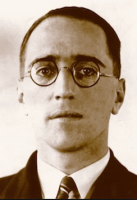










Alan Dower Blumlein was an English electronics engineer, notable for his many inventions in telecommunications, sound recording, stereophonic sound, television and radar.He received 128 patents and was considered as one of the most significant engineers and inventors of his time.
Alan Dower Blumlein was born in 1903 in London. His father, a mining engineer, was a naturalised British subject from Germany. Alan was awarded a first class BSc degree following education at Highgate School and City and Guilds College in 1923. He joined International Western Electric Corp and Standard Telephones and Cables in 1924, and was involved in long distance telephonic communication in Europe. He was awarded a prize for his contribution at the age of 23.
In 1929 Blumlein started work for the Columbia Graphophone Company. Within a short time he produced an advanced moving coil wax cutting machine for cutting gramophone record masters. He also designed a moving coil microphone. About 1930 he became interested in stereophonic recording and reproduction. His work resulted in an outstanding patent on the subject and a new method of cutting stereo disks.
About this time he developed some circuit design principles to make circuit behaviour less dependent on valve characteristics. The current passed by a valve with a fixed bias varied from valve to valve so much that sometimes, on a production line, valves were selected for particular characteristics. Blumlein developed the principle of defined current circuits in which the valve's current was defined either by a cathode resistance to a considerably lower potential, or by employing negative feedback. These principles together with the long-tailed pair were patented in about 1936. Upon these principles were built other circuit ideas including the wide-band DC coupling. During the war these principles survived the rigours of quantity production in a factory under military specifications and, after the war. were used in the design of the ACE Pilot Model, the Deuce and the ACE.
Before the opening of the London television station at Alexandra palace in 1936, Blumlein's activities were devoted to the engineering of the 405 line system. At this time scanning was performed by mechanical spinning disks. In 1931 the Gramophone Company (HMV) merged with the Columbia Graphophone Company to form Electric and Musical Industries. This started a major research into the design and manufacture of vacuum cathode ray tubes. This work lead on to the development of the iconoscope tube for cameras. This effort was crowned by the outside televising of the coronation procession in 1937, linked by an eight mile cable to the transmitter. A new type of aerial was needed for this and Blumlein invented the resonant slot aerial.
In 1939 the Company developed a 60 MHz radar patented by Blumlein and E L C White. Blumlein was involved with a visual display for the stereo sound locators in use for gun laying. By 1940 it was delivering airborne interception radar for Beaufighters. In 1941 work began on H2S, a radar system to aid bombers to find their target. It was during the testing of this equipment that Blumlein, Browne and Blythen of EMI Research Laboratories together with three TRE staff were killed in a disastrous air crash. In spite of this H2S became operational in 1943 and some units were allocated to the detection of enemy submarines. This made a substantional contribution to the Battle of the Atlantic.
After the crash, Ted Newman, who had joined the Laboratory at about the beginning of the war, became responsible for the further development of H2S and other military projects. After the war he was involved in the development of television cameras. David Clayden, who joined the Laboratory in 1941, also absorbed Blumlein's design principles, and both Newman and Clayden employed these principles in the design of the ACE Pilot Model and the ACE when they moved to the Radio Division of NPL in September 1947.
Blumlein was a remarkably prolific, versatile and inventive engineer. His capacity for hard work was immense and he often worked into the small hours, seven days per week. In 1933 he married Doreen and had two sons, Simon and David. It was Simon who gave the annual Blumlein lecture at the IEE in April 2000.
Although Alan was killed at the age of 38, his contributions to electronic engineering embraced many aspects of the discipline. The breadth of these contributions can be gauged by the fact that he produced 128 patents as well as writing two IEE papers and some popular papers in Wireless World.